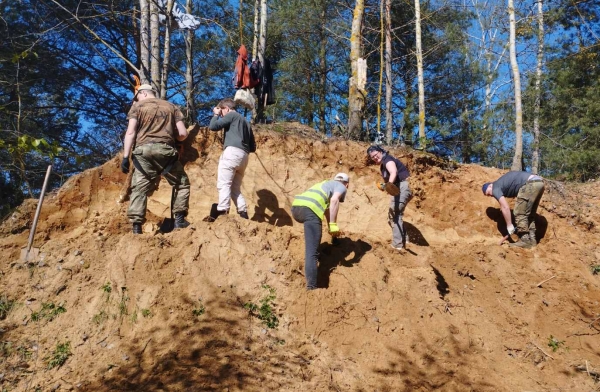
With new comprehensive studies of the unique Stone Age man site Agova 1 (Agova village, Ivanawski district, Brest region) Belarusian and Russian archaeologists have found new artifacts about 200 thousand years old. The expedition is international. Students of the Faculty of Geography and Geoinformatics of BSU, scientists of the Institute of the History of Material Culture of the Russian Academy of Sciences (St. Petersburg) and the Institute of Geography of the Russian Academy of Sciences (Moscow) work with archaeologists of the Institute of History of the National Academy of Sciences of Belarus.
The head of the expedition, researcher of the Department of Archeology of the Primitive Society of the Institute of History of the National Academy of Sciences of Belarus Alexander Vashanov informed the leadership of the Institute that new artifacts were found during the excavation of the man site. These are flint choppers, several scrapers, flakes. Geologists confirm the age of the monument at least 200 thousand years, with the possibility of attribution to an earlier period based on the results of a detailed study of the materials obtained. On the territory of the man site, archaeologists cleaned the sections, began work on sampling for granulometry and palynology.
The Institute of History of the National Academy of Sciences of Belarus, together with Russian colleagues, has begun new comprehensive studies of the unique Stone Age site Agova 1 (Agova village, Ivanawski district, Brest region). Agova is a monument of the Lower/Early Middle Paleolithic, about 250 thousand years BC, which makes it the oldest on the territory of Belarus and one of the oldest within Eastern Europe. In the course of last year's archaeological work, flint tools with double-sided processing, choppers, numerous debitage forms, scrape-like and nucleoid forms were found.
The research is carried out within the framework of The Concept of Formation and Implementation of The Most Significant National Archaeological Projects, which was prepared following the visit of the Prime Minister of the Republic of Belarus Roman A. Golovchenko to the Institute of History of the National Academy of Sciences of Belarus on June 3, 2022.
In the Concept of The Formation and Implementation of The Most Significant National Archaeological Projects, prepared, among other things, taking into account the proposals of the Ministry of Culture, regional executive committees and the Minsk City Executive Committee, the most unique objects in all regions of the country were selected for scientific study and further practical use. The most extensive research in 2023 in the Minsk region will be excavations at the Archaeological Complex on the Mienka River. In the Vitebsk region, in the Beshankovicki and Sennenski districts, a comprehensive study of the primitive settlements of the Kryvinski peat bog will continue, including by methods of underwater archaeology, in the Dragichynski district of the Brest region – a multicultural archaeological monument of the period of the final Paleolithic – early Bronze Age Kakoryca 4.